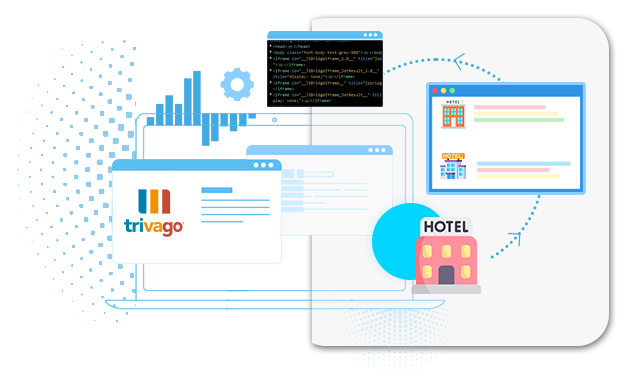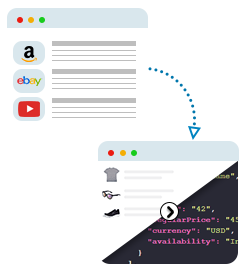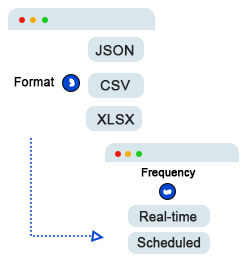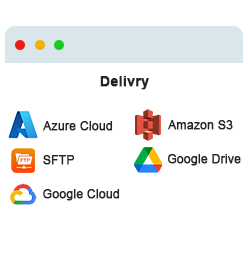Data scraping involves extracting information from websites or online sources using automated tools or scripts. Trivago data scraping implies programmatically collecting data from the Trivago website. Trivago is a popular hotel and accommodation booking platform that provides information on hotel prices, availability, and reviews from various sources across the web. A "Trivago data scraper" is a computer program or script designed to automate gathering information from the Trivago website. We offer the best Trivago data scraping services, designed to provide our clients comprehensive and up-to-date information from the Trivago platform. Our expert team of data scraping professionals helps extract valuable data such as hotel prices, availability, reviews, and more to meet your business needs.

Trivago Travel data Scraper

Use iWeb Data Scraping Data Collecor,
or purchase an Trivago
dataset
- Scrape Trivago to compare your prices and inventory
- Identify Trivago top sellers to stay ahead of the competition
- Collect Trivago data to track consumer sentiment
- Optimize your pricing, supply chain, and marketing strategy
Trivago Data Scraper Overview
- A Trivago Data Scraper offers the flexibility to tailor the scraping process to your specific requirements. You can define which data fields or information you want to extract from the Trivago website.
- A Trivago Data Scraping tool often includes proxy support To prevent IP bans. This feature allows the scraper to route its requests through a pool of proxy servers, making it appear that the requests originate from different IP addresses.
- Concurrency is a critical feature that enables the Trivago Data Scraper to execute multiple scraping requests simultaneously. This concurrent processing of requests enhances the efficiency and speed of data extraction.
- After scraping data from Travel and hotel booking platforms, a capable scraper can parse and structure the collected information into a usable format. This format could be CSV, JSON, or even a database.
- Scheduled scraping is an automation feature that allows you to set up scraping tasks to run at specific intervals or on a predefined schedule. This automation ensures you consistently receive updated data from Trivago without manual intervention.
- To mimic different web browsers or devices and avoid detection and blocking by Trivago, a Trivago Data Scraping tool may offer user-agent rotation. The user-agent is a string that identifies the web browser.
What You Can Do With The Data Collected With Trivago Data Extractor
- Data extracted from Trivago helps analyze the pricing strategies, availability, and customer reviews of hotels and accommodations. This information helps businesses understand their competitors and make informed decisions to stay competitive.
- Data collected from Trivago allows users to compare prices for the same hotels or accommodations across different platforms and booking websites. It can help travelers find the best deals and save money.
- The data collected is helpful in market research to identify trends in the hospitality industry, such as popular destinations, average pricing, and customer preferences. This information is valuable for making strategic business decisions.
- Scrape data from booking platforms to create valuable content for travel websites, blogs, or apps. User-generated content can enhance the user experience and improve engagement.
- Hotel owners and managers can use the data to adjust their pricing strategies, marketing efforts, and services based on customer feedback and competitive insights gathered from Trivago.
- For businesses in the hospitality industry, having access to real-time data on room availability and pricing can help with efficient inventory management and revenue optimization.
- Travel agencies or booking platforms can use the data collected to provide personalized hotel recommendations, enhancing the user experience and increasing customer satisfaction.
How it works
-
STEP 1
Choose the website you would like to scrape public data from, in real-time.

-
STEP 2
Select the frequency: real-time or scheduled, and delivery format: JSON, CSV, HTML, or Microsoft Excel.

-
STEP 3
Decide where to send the data: webhook, email, Amazon S3, Google Cloud, Microsoft Azure, SFTP, or API.

Want to learn more?
Talk to an expert to discuss your data collection needs and see our platform in action.
Let’s Talk About Product
What's Next?
We start by signing a Non-Disclosure Agreement (NDA) to protect your ideas.
Our team will analyze your needs to understand what you want.
You'll get a clear and detailed project outline showing how we'll work together.
We'll take care of the project, allowing you to focus on growing your business.
